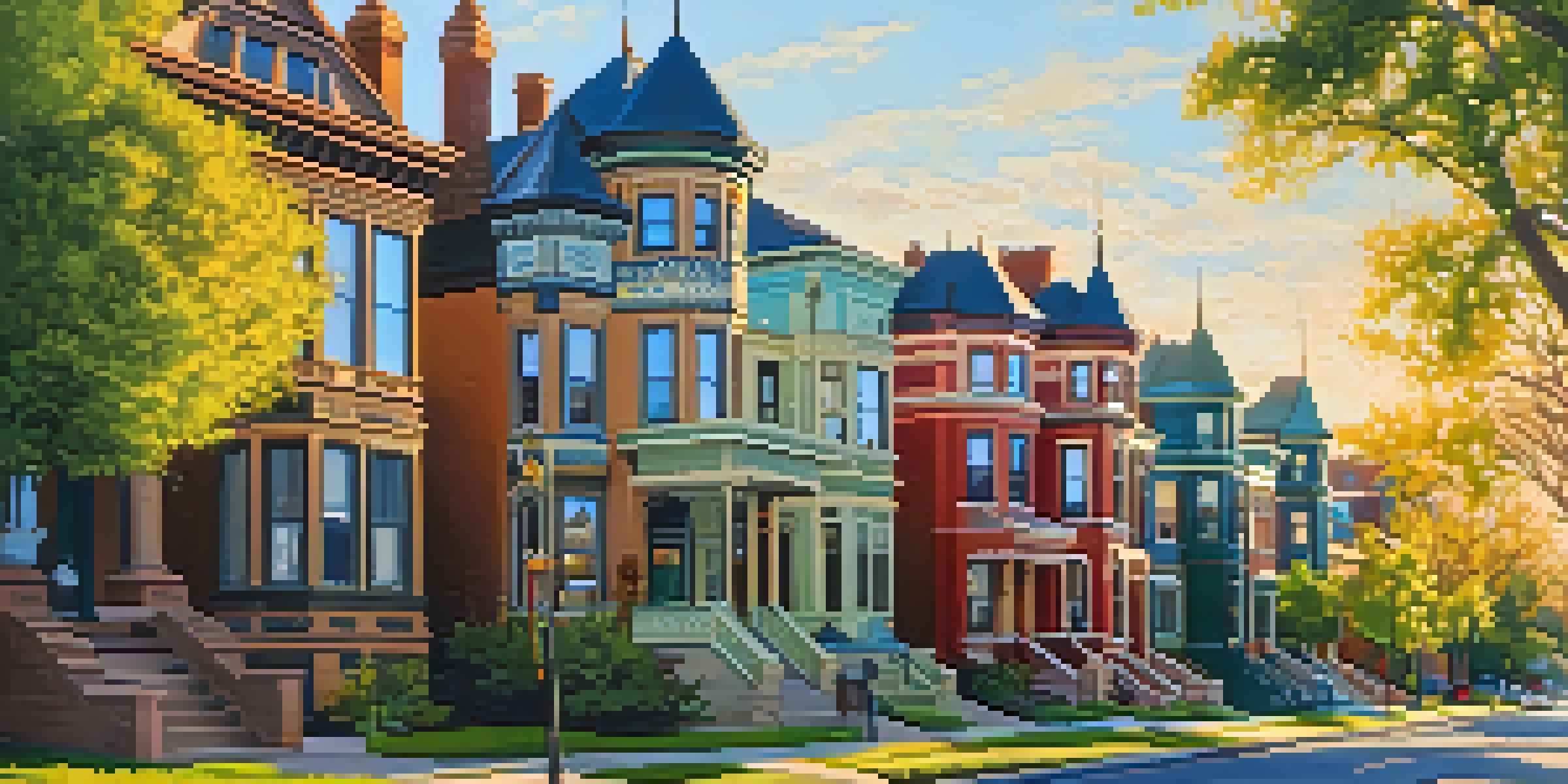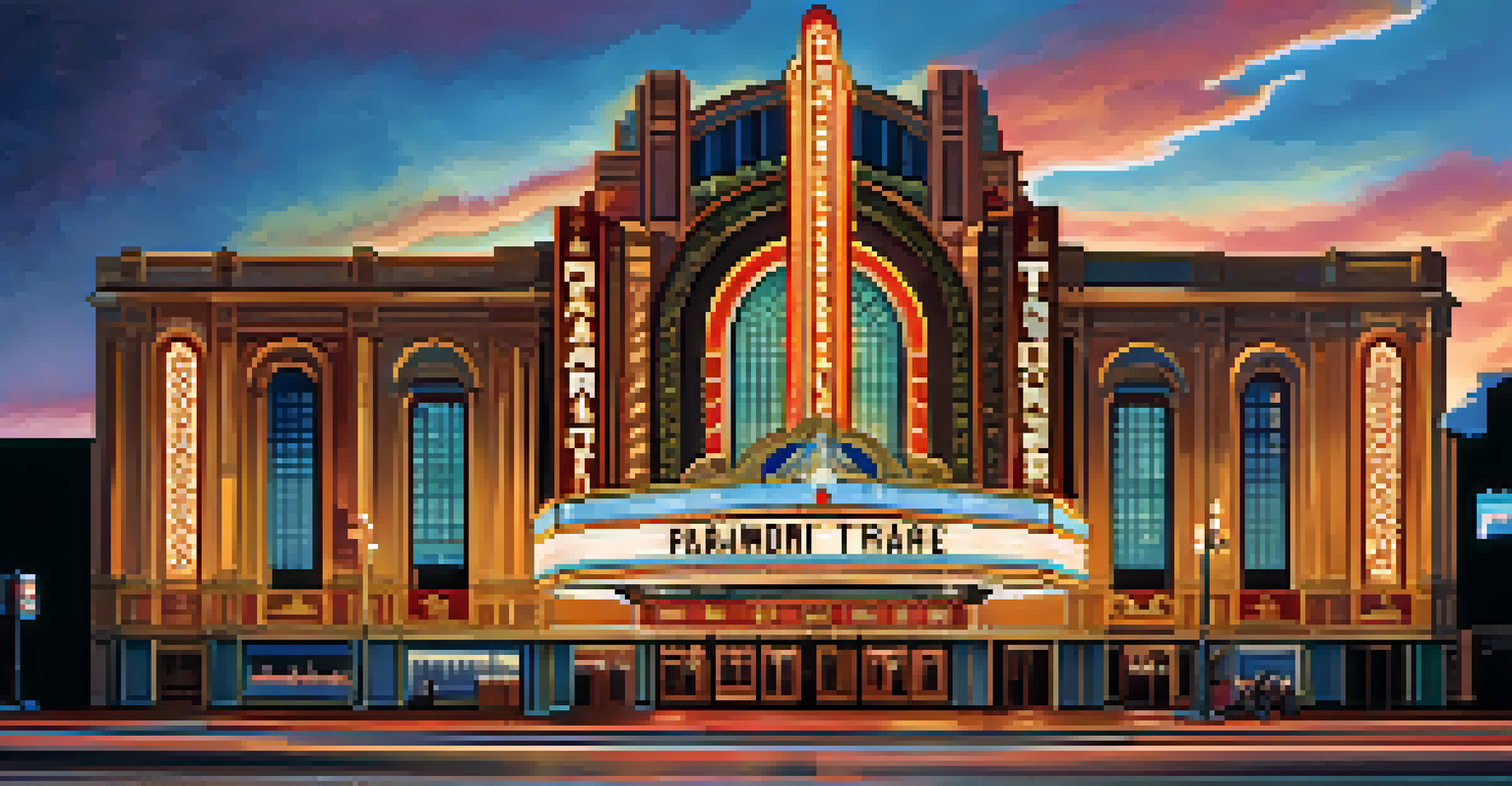Exploring Denver's Unique Blend of Modern and Historic Architecture

A Brief Overview of Denver's Architectural Landscape
Denver's architecture is a captivating tapestry woven from various historical and modern influences. The city boasts structures that reflect its rich past while embracing contemporary design. From the iconic Denver Union Station to the sleek lines of the Museum of Contemporary Art, Denver offers a visual feast for architecture enthusiasts.
Architecture is the learned game, correct and magnificent, of forms assembled in the light.
Walking through Denver is like flipping through a history book, with buildings telling stories of different eras. Each neighborhood has its own distinct flavor, showcasing a mix of styles that range from Victorian to mid-century modern. This unique blend gives the city a character that is both inviting and intriguing.
As you explore, you'll notice how the old and new coexist harmoniously, creating a vibrant urban environment. This architectural diversity not only adds aesthetic value but also enriches the cultural fabric of the city, making Denver a must-visit for anyone interested in architecture.
The Influence of Victorian Architecture in Denver
Victorian architecture holds a special place in Denver's historical narrative. This style flourished in the late 19th century and is characterized by ornate details, asymmetrical shapes, and vibrant colors. Historic districts like Capitol Hill showcase beautifully restored Victorian homes that transport you back in time.

These homes often feature intricate woodwork, bay windows, and expansive porches, offering a glimpse into the luxurious lifestyles of Denver's early settlers. Walking through these neighborhoods, you can almost hear the echoes of horse-drawn carriages and lively social gatherings. It's a charming reminder of a bygone era.
Denver's Architectural Diversity
Denver's architecture blends historical and modern influences, creating a vibrant urban environment that captivates residents and visitors.
Preserving these Victorian treasures is crucial for maintaining Denver's heritage. The contrast between these historic homes and the surrounding modern developments creates a fascinating dialogue between past and present, inviting residents and visitors alike to appreciate the city's architectural evolution.
Art Deco: The Glamour of the 1920s in Denver
Stepping into the world of Art Deco in Denver is like stepping into a glamorous movie set from the 1920s. This architectural style, marked by its bold geometric shapes and lavish ornamentation, can be seen in several buildings across the city. The Paramount Theatre is a prime example, showcasing stunning details that capture the essence of this vibrant era.
The best way to predict the future is to design it.
Art Deco was more than just a design style; it represented a cultural shift towards modernity and elegance. Many commercial buildings from this time period feature colorful tiles and intricate metalwork, making them stand out amidst the more subdued architecture that surrounds them. It's fascinating to see how this style influenced the city's commercial landscape.
As you explore Denver, keep an eye out for these Art Deco gems, as they offer a glimpse into the city's ambitious spirit during the Roaring Twenties. The juxtaposition of these glamorous structures against contemporary designs creates a unique visual narrative, celebrating both history and innovation.
Modernism: A New Era of Architectural Innovation
The modernist movement brought a fresh perspective to architecture, and Denver is no exception. Characterized by simplicity, clean lines, and functional design, modern architecture can be seen in several key buildings throughout the city. The Denver Art Museum, with its striking angles and innovative use of space, is a standout example of this style.
Modernism encourages a connection between the indoors and outdoors, emphasizing open floor plans and natural light. This philosophy is evident in many contemporary homes and commercial spaces in Denver, creating environments that feel spacious and inviting. It reflects a shift towards a more sustainable approach to living and working.
Focus on Sustainability
The city prioritizes eco-friendly building practices, integrating green initiatives that enhance both the environment and quality of life.
As you stroll through neighborhoods like RiNo (River North Art District), you'll see how modern architecture coexists with historic buildings, creating a dynamic urban landscape. This blend of styles not only highlights Denver's architectural evolution but also showcases the city's commitment to innovation and creativity.
Sustainable Architecture: Denver's Green Initiatives
Sustainability is a key focus in Denver's architectural landscape, reflecting a growing awareness of environmental issues. Many new developments prioritize eco-friendly materials and energy-efficient designs, aiming to reduce the city's carbon footprint. The National Renewable Energy Laboratory is a prime example of how sustainability can be seamlessly integrated into architecture.
Green roofs, solar panels, and rainwater harvesting systems are becoming standard features in both commercial and residential buildings. This commitment to sustainability not only benefits the environment but also enhances the quality of life for Denver's residents. It's a win-win situation that showcases the city’s forward-thinking approach.
Denver's dedication to sustainable architecture demonstrates a broader trend toward responsible urban development. By prioritizing eco-friendly designs, the city sets an example for others to follow, proving that modern living can harmoniously coexist with environmental stewardship.
Cultural Influences: The Impact on Denver's Architecture
Denver's architecture is a reflection of its diverse cultural landscape. Various communities have left their mark on the city's buildings, contributing to a rich architectural tapestry. From the ornate Spanish colonial revival structures to the sleek designs influenced by Asian aesthetics, each style tells a story of cultural exchange and collaboration.
This diversity is particularly evident in neighborhoods like Five Points, known for its rich African American heritage. Here, you'll find buildings that celebrate the community's history and resilience, adding depth to the architectural narrative of the city. These cultural influences enrich the overall aesthetic and foster a sense of belonging.
Cultural Influences in Design
Denver's architectural landscape reflects its diverse cultural heritage, with various styles that tell stories of community and collaboration.
As you explore Denver, take time to appreciate how these cultural influences shape the architectural landscape. It’s a reminder that buildings are more than just structures; they are representations of the communities they serve and the stories they hold.
Preserving the Past: The Importance of Historic Preservation
Historic preservation plays a vital role in maintaining Denver's unique architectural identity. The city has made significant efforts to protect and restore historic buildings, ensuring that future generations can enjoy their beauty and significance. Organizations like the Denver Landmark Preservation Commission work tirelessly to safeguard the city’s architectural heritage.
Preserving these structures not only honors the past but also enhances the character of neighborhoods. It encourages a sense of pride among residents and fosters community engagement. Moreover, historic buildings often attract tourism, contributing to the local economy and promoting cultural education.

As you wander through Denver, take a moment to appreciate the preservation efforts that have allowed the city to retain its charm. The blend of historic and modern architecture creates a unique narrative, reminding us of the importance of honoring our roots while embracing the future.